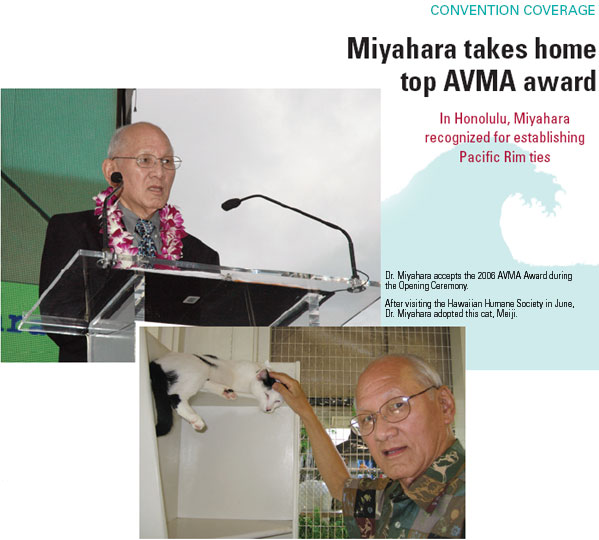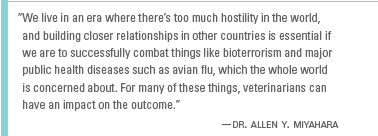Miyahara takes home top AVMA award

Dr. Allen Y. Miyahara of Honolulu has spent the better part of his 52-year career forging ties with veterinarians around the globe in an effort to strengthen the veterinary profession internationally.
Most recently, he served as the AVMA ambassador for Pacific Rim development for the 2006 AVMA Annual Convention in Hawaii. Because of Dr. Miyahara's efforts, approximately 450 veterinarians, veterinary technicians, and others from China, Japan, Korea, the Philippines, and Taiwan attended the convention.
"Our goal was to have veterinarians from the Orient attend the largest veterinary meeting ever held in the Pacific, and to give them an opportunity to establish closer ties with our leaders and educators that could help them obtain their goals in the future," Dr. Miyahara said during convention at the Opening Ceremony, sponsored by Hill's Pet Nutrition Inc.
During the ceremony, Dr. Miyahara received the 2006 AVMA Award, which recognizes distinguished contributions to the advancement of veterinary organizations.
"We live in an era where there's too much hostility in the world, and building closer relationships in other countries is essential if we are to successfully combat things like bioterrorism and major public health diseases such as avian flu, which the whole world is concerned about," he continued. "For many of these things, veterinarians can have an impact on the outcome."
Dr. Miyahara graduated in 1954 from the Iowa State University College of Veterinary Medicine. His interest in the Pacific Rim was sparked by a chance meeting with a veterinarian from Japan at the Hawaii VMA annual meeting in 1972. As executive vice president of the state association at that time, Dr. Miyahara encouraged more Japanese practitioners to attend the conference during subsequent years and offered them fully translated educational sessions. As a result, approximately 250 veterinarians, veterinary technicians, and veterinary technician students from Japan annually travel to the Hawaii state meeting.
Dr. Miyahara also developed relationships while attending the biannual meetings of the Federation of Asian Veterinary Associations. During the conferences, he encouraged FAVA members to attend the AVMA Annual Convention in Hawaii. He also promoted the AVMA while visiting veterinary schools and private practices in the Pacific Rim.
Dr. Miyahara's in-depth knowledge of the Association stems from his experience as AVMA vice president from 1995-1997, during which he spent ample time working with the Student AVMA. He has also served as an AVMA alternate delegate to the House of Delegates for 25 years.
"Over the years, I've been the intermediary between the AVMA and the Japan VMA," he said. "Unless they know you personally, they don't want to contact you. They feel awkward about it." Dr. Miyahara said that the 2006 convention served as an opportunity for all the presidents of the associations and companies to connect.
At convention, the AVMA provided four days of educational programming translated into Chinese Mandarin, Japanese, and Korean. In addition, Dr. Miyahara noted that many of the attendees from the Pacific Rim comprehend English. Another valuable source of information was the AVMA exhibit hall. In the Pacific Rim, he said, veterinary conferences typically have considerably fewer exhibiting companies than U.S. conferences.

There are a number of differences between the veterinary profession in the Pacific Rim and in the United States. Dr. Miyahara pointed out, for example, that many countries in the Pacific Rim don't have colleges of veterinary medicine; rather, they have departments of veterinary medicine within a college of agriculture.
"We've been trying to get one or more of the Japanese schools to work toward getting their schools accredited by the AVMA, and particularly so since there are no schools in the (region) that have achieved this," Dr. Miyahara said. "Luckily, last October, we were invited to make a presentation at the largest annual meeting held in Japan about educational standards in the United States and our accreditation process."
Another difference is that the veterinary profession in the Pacific Rim tends to focus more on livestock than on companion animals. However, as the countries' economies have improved and the recognition of the human-animal bond has grown, he said, small animal medicine has become stronger.
In 1980, Dr. Miyahara organized one of the earliest and most comprehensive programs on the human-animal bond and invited 10 of the more prominent authorities on the subject, including Dr. Leo K. Bustad. Held in Honolulu, the meeting led to the establishment of strong educational programs on the subject in Hawaii and Japan. Dr. Miyahara has also given lectures on the subject in China, Korea, Taiwan, and Thailand.
AVMA awards continue here.